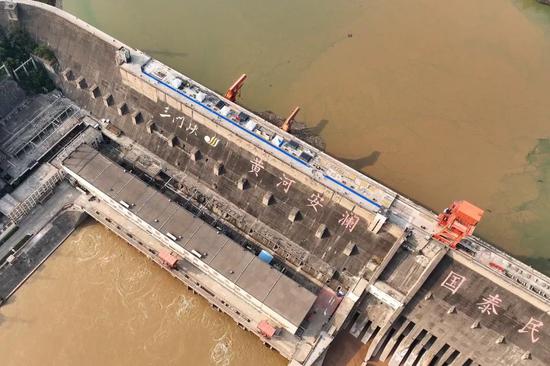
People practice a ribbon dragon dance under the Drum Tower in Beijing on Saturday. (Photo by Cheng Gong/For China Daily)
After years of comprehensive renovations, the old neighborhoods surrounding Beijing's centuries-old landmarks have been revitalized, bridging traditional and modern living while becoming part of a popular tourist route.
Zhonglouwan Hutong, located near Beijing's iconic Drum Tower and Bell Tower in Dongcheng district, is the closest hutongto Beijing's Central Axis, the newly recognized UNESCO World Heritage Site. With a rich history, the traditional alley has attracted tourists from around the world eager to experience the authentic "Beijing life".
"This area is really beautiful with so many old buildings, and the atmosphere here is really chill and relaxed," said Arnold Geels, a tourist from the Netherlands who encountered local seniors playing shuttlecock on Saturday morning in a community park in front of the Drum Tower.
"It's my first time and first day in China," he said. "The Drum and Bell towers are our first site during our seven-day China tour. I love ancient buildings, and it's cool to see locals are living a peaceful life in the ancient buildings here. The weather is great, too!"
However, like other old neighborhoods in Beijing's historic core, Zhonglouwan Hutong had various problems, including dilapidated buildings, illegal structures, limited parking and cramped living spaces that made life uncomfortable for residents and visits messy for tourists.
"Based on the functional role of the city's core area and its current conditions, we've explored ways to improve the urban environment, from streets and alleys to entire blocks, creating a three-dimensional space that includes scenic corridors," said Wang Tao, deputy director of the Dongcheng district's urban management commission.
Since the citywide environmental improvement initiative for streets and alleys in 2018, Dongcheng has focused on meeting residents' needs by upgrading power, telecommunications, lighting, drainage and roads in Zhonglouwan Hutong. These measures have enhanced public spaces, highlighted the area's cultural heritage and made life more comfortable for locals.
"We're not trying to restore the hutongto a specific period, but rather preserve their historical essence while adapting them for modern living," said Tan Tao, a designer with the Tsinghua Tongheng Urban Planning and Design Institute.
Designers have carefully traced the cultural significance of each house and alley, updating and renovating them to align with contemporary lifestyles, with the guiding principle to restore the old while embracing the new.
"Look at my courtyard now — smooth ground, renovated houses and motion-sensor lights. It's so much better than before," said Fan Laiyou, a longtime resident in thehutong. "I often invite friends over to enjoy the beautiful views of the Drum Tower and Bell Tower from my home."
Since the completion of the renovations over the years, many idle courtyard spaces have emerged in Zhonglouwan Hutong. The local government has transformed these spaces, converting some into offices or businesses, while others have been repurposed for new industries, creating more public service areas for the community.
For example, one of the courtyards has become a mini firefighting station to protect the residents and cultural heritage sites nearby, and another was changed into a nursing home for the elderly, one of the first 80 such care centers built in Beijing.
"Through these renovation projects, Zhonglouwan Hutong and the surrounding community have gradually become a vibrant, fully functional and charming neighborhood," said Zhang Yu, head of the urban management office of Andingmen subdistrict, where the hutongis located.
In 2023, Zhonglouwan Hutong was recognized as one of Beijing's "10 Most Beautiful Hutong", drawing more tourists eager to explore its unique culture and charm.
The transformation of a single hutongreflects the broader progress of backstreet management across the city.
As part of Beijing's three-year action plan (2023-25) for improving backstreets and alleys, the city aims to enhance 5,393 alleys, including areas neglected due to demolition delays. This year, 2,114 alleys are slated for makeovers. Of these, 1,598 had been renovated by the end of August, achieving a 75.6 percent completion rate, according to the city government.


















































 京公网安备 11010202009201号
京公网安备 11010202009201号